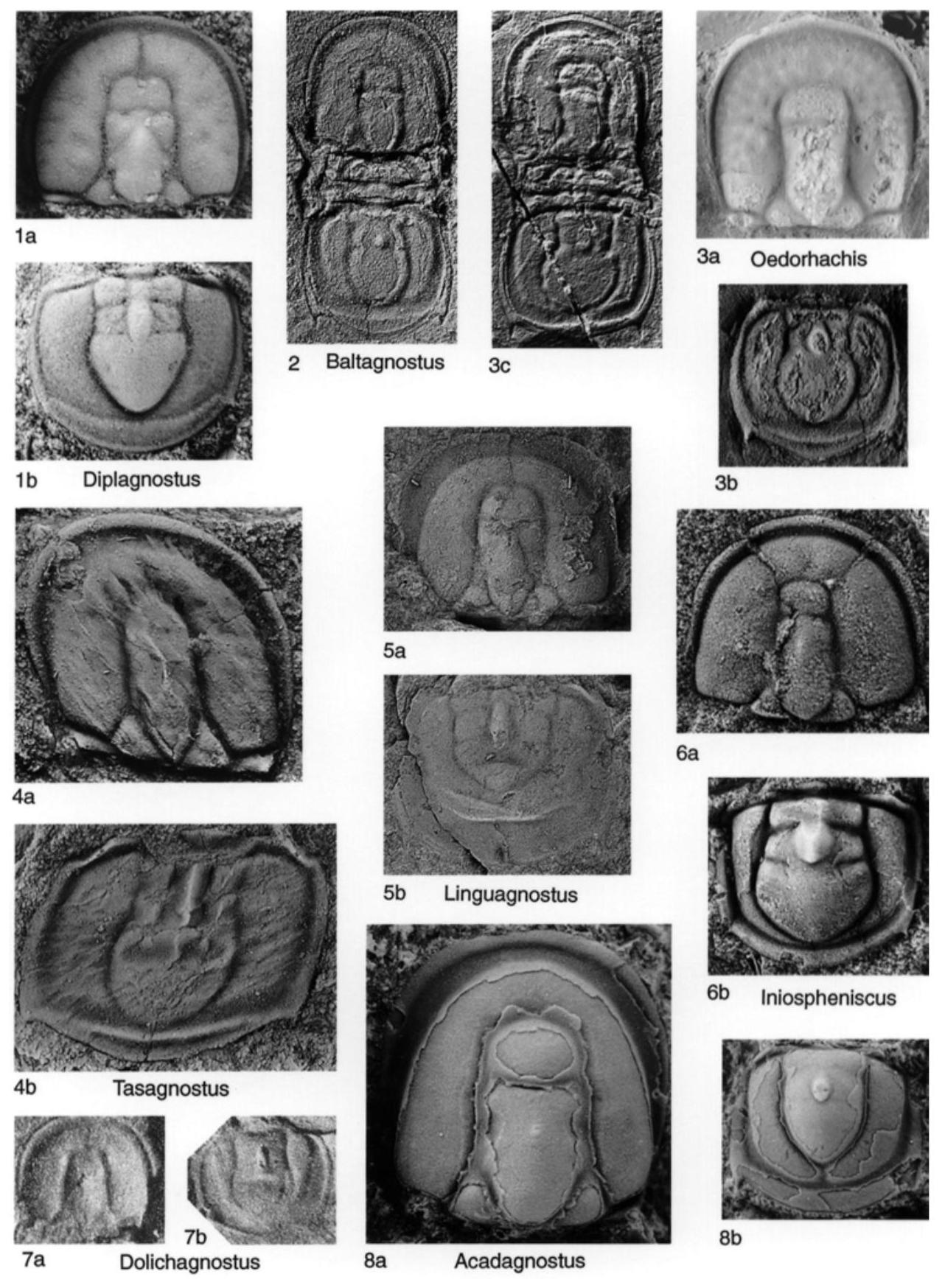Welcome to the Treatise on Invertebrate Paleontology!
Please enter a genera name to retrieve more information.

Diplagnostus
Classification
Phylum:
Arthropoda
Class:
Trilobita
Order:
Agnostida
Superfamily:
Agnostoidea
Family:
Diplagnostidae
Subfamily:
Diplognostinae
Formal Genus Name and Reference:
Diplagnostus Jaekel, 1909, p. 396, Enetagnostus WHITEHOUSE, 1936, p. 91
Type Species:
* Agnostus planicauda Angelin, 1851, p. 7, OD, location of types unknown (topotypes illustrated by WESTERGARD, 1946, pl. 8, fig. 22-24)
Images
(Click to enlarge in a new window)
Fig. 230,1a,b. *D. planicauda (A NGELIN ), Middle Cambrian (Goniagnostus nathorsti Zone), Sweden (Andrarum, Skåne); a, topotype, cephalon, SGU 4870, ×9; b, topotype, pygidium, SGU 4871, ×9 (new).
Synonyms
Enetagnostus
Geographic Distribution
Argentina; northern Greenland; Sweden, P. punctuosus to L. laevigata Zones; Denmark, Norway, L. laevigata Zone; England, P. aurora to T. fissus Zones; France, Paradoxides beds; Canada (Newfoundland), P. davidis Zone; Turkestan Mountain Range, Kazakhstan (Tyan-Shan Range), Amgaian; Russia (southeastern Siberia), T. fissus to L. laevigata Zones; China (Zhejiang), P. triangularis to L. armata Zones, (Hunan, Guizhou, Qinghai), upper Middle Cambrian; Australia (Queensland, Tasmania), P. atavus to L. laevigata Zones.
Age Range
Beginning Stage in Treatise Usage:
Middle Cambrian
Beginning International Stage:
Cambrian Stage 4
Fraction Up In Beginning Stage:
40
Beginning Date:
512.3
Ending Stage in Treatise Usage:
Middle Cambrian
Ending International Stage:
Guzhangian
Fraction Up In Ending Stage:
50
Ending Date:
498.75
Description
Cephalon commonly scrobiculate, deliquiate to subdeliquiate border furrows with narrow border in cephalon and zonate border in pygidium, unconstricted acrolobes, median preglabellar furrow well developed to absent. Glabella with trapeziform to subrectangular anterior lobe, commonly with median sulcus, F3 clearly impressed, F2 well developed or absent, glabellar node level with or slightly in front of F2 furrows. Pygidium bispinose, axis long, broad, ogival, commonly extending to border furrow or connected to it by median postaxial furrow, F1 clearly impressed laterally, F2 clearly impressed, posterior lobe ogival to subtriangular, commonly with poorly defined transverse depression at about midlength, pygidial collar always well defined, extending across entire posterior margin between pygidial marginal spines, but not extending onto acrolobe.
References
Jaekel, O. 1909. Über die Agnostiden. Zeitschrift der Deutschen Geologischen Gesellschaft 61:380-401, 23 fig.
Museum or Author Information
Classification
Phylum:
Arthropoda
Class:
Trilobita
Order:
Agnostida
Superfamily:
Agnostoidea
Family:
Diplagnostidae
Subfamily:
Diplognostinae
Formal Genus Name and Reference:
Diplagnostus Jaekel, 1909, p. 396, Enetagnostus WHITEHOUSE, 1936, p. 91
Type Species:
* Agnostus planicauda Angelin, 1851, p. 7, OD, location of types unknown (topotypes illustrated by WESTERGARD, 1946, pl. 8, fig. 22-24)
Images
(Click to enlarge in a new window)
Fig. 230,1a,b. *D. planicauda (A NGELIN ), Middle Cambrian (Goniagnostus nathorsti Zone), Sweden (Andrarum, Skåne); a, topotype, cephalon, SGU 4870, ×9; b, topotype, pygidium, SGU 4871, ×9 (new).
Synonyms
Enetagnostus
Geographic Distribution
Argentina; northern Greenland; Sweden, P. punctuosus to L. laevigata Zones; Denmark, Norway, L. laevigata Zone; England, P. aurora to T. fissus Zones; France, Paradoxides beds; Canada (Newfoundland), P. davidis Zone; Turkestan Mountain Range, Kazakhstan (Tyan-Shan Range), Amgaian; Russia (southeastern Siberia), T. fissus to L. laevigata Zones; China (Zhejiang), P. triangularis to L. armata Zones, (Hunan, Guizhou, Qinghai), upper Middle Cambrian; Australia (Queensland, Tasmania), P. atavus to L. laevigata Zones.
Age Range
Beginning Stage in Treatise Usage:
Middle Cambrian
Beginning International Stage:
Cambrian Stage 4
Fraction Up In Beginning Stage:
40
Beginning Date:
512.3
Ending Stage in Treatise Usage:
Middle Cambrian
Ending International Stage:
Guzhangian
Fraction Up In Ending Stage:
50
Ending Date:
498.75
Description
Cephalon commonly scrobiculate, deliquiate to subdeliquiate border furrows with narrow border in cephalon and zonate border in pygidium, unconstricted acrolobes, median preglabellar furrow well developed to absent. Glabella with trapeziform to subrectangular anterior lobe, commonly with median sulcus, F3 clearly impressed, F2 well developed or absent, glabellar node level with or slightly in front of F2 furrows. Pygidium bispinose, axis long, broad, ogival, commonly extending to border furrow or connected to it by median postaxial furrow, F1 clearly impressed laterally, F2 clearly impressed, posterior lobe ogival to subtriangular, commonly with poorly defined transverse depression at about midlength, pygidial collar always well defined, extending across entire posterior margin between pygidial marginal spines, but not extending onto acrolobe.
References
Jaekel, O. 1909. Über die Agnostiden. Zeitschrift der Deutschen Geologischen Gesellschaft 61:380-401, 23 fig.
